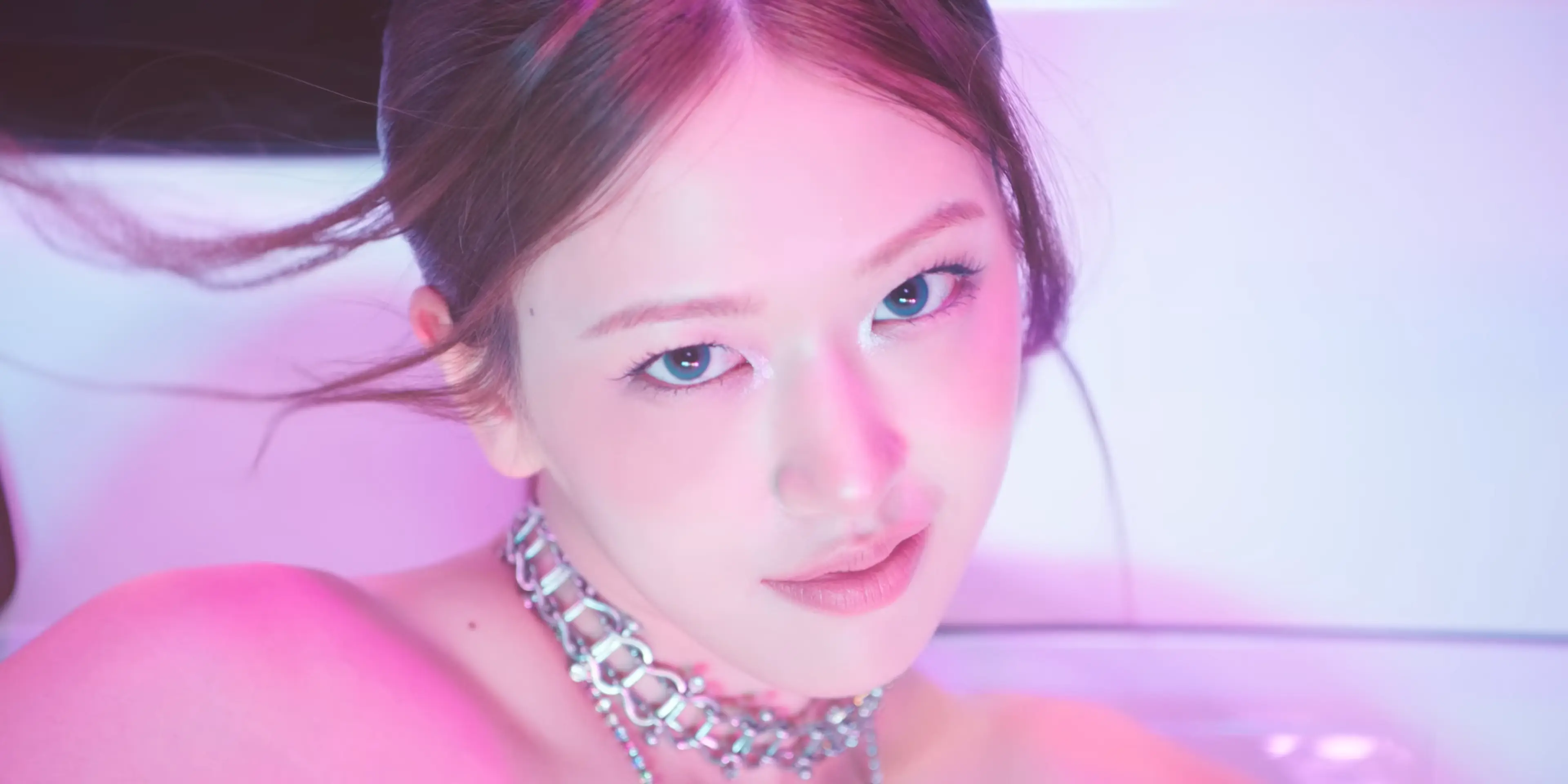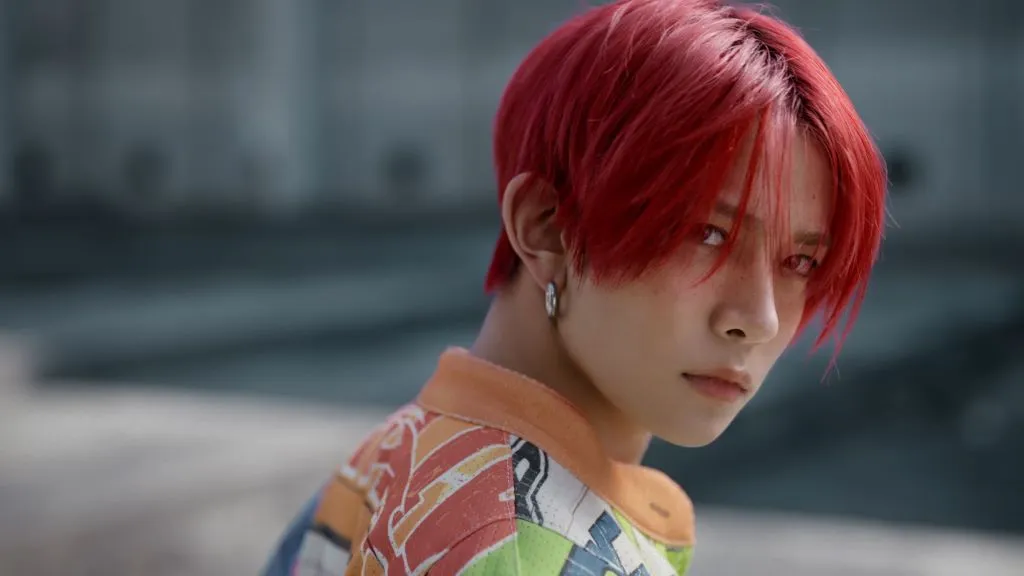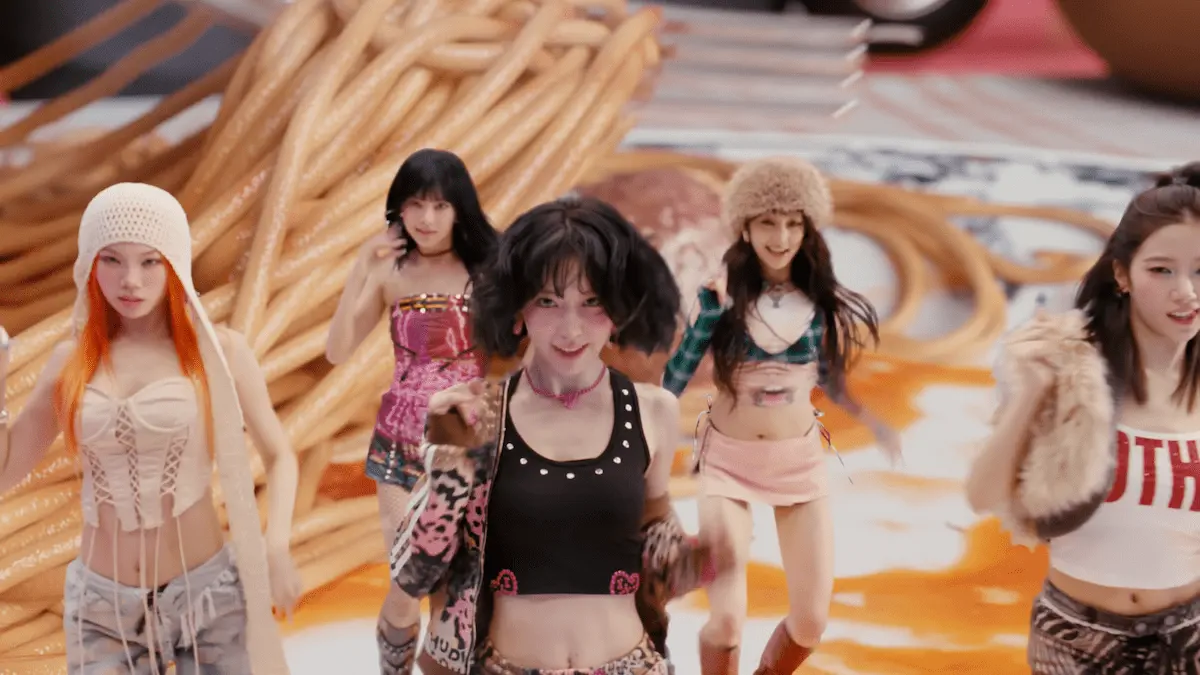IVE's 'XOXZ' Explained: The Dream You Don't Want to Wake Up From
I’ll be honest—XOXZ didn’t grab me immediately. First listen, I thought “this is pretty but kinda subdued for IVE.” Second listen, I started noticing details. Third listen, I realized why the comment section was going absolutely feral: this is one of those songs that reveals itself slowly, and the MV is doing way more narrative work than it appears.
At 2:37, it’s IVE’s shortest title track. But after spending way too much time analyzing this thing, I’m convinced it’s also their most carefully constructed visual story. There’s dream logic embedded in the set design, the editing creates a specific sleep-stage narrative, and that whispered “XOXZ” at the start isn’t just aesthetic—it’s setting up the entire concept.
Let me walk you through what’s actually happening here, because there’s a lot under the surface.

Source: Official IVE YouTube (© Starship Entertainment)
Quick Navigation
- First Watch vs. Fifth Watch
- Credits & Context
- The Dream Structure: How the MV Mirrors Sleep
- Visual Breakdown: Three Worlds, One Logic
- The Rei Moment Everyone's Talking About
- Musical Layers: Why This Grew On Me
- What "XOXZ" Actually Means
- Why This Works (Even When It Shouldn't)
- Q&A: Your Questions Answered
- Sources & Credits
First Watch vs. Fifth Watch
First watch: Pretty, dreamy, kind of restrained for IVE. Nice visuals. Solid but not mindblowing.
Fifth watch: Oh wait—the text is backwards. The truck isn’t random. Rei’s glitching at the end is intentional. The bowling alley doesn’t make sense on purpose. This entire thing is structured like actual REM sleep.
That shift in perception is the whole point. XOXZ rewards attention in a way their previous tracks didn’t need to. LOVE DIVE hits you immediately. I AM is instant swagger. This? This makes you work for it, which is either frustrating or fascinating depending on your patience level.
I kept seeing comments about specific moments—Rei at 1:24, Liz at 1:42, that weird outro at 2:20. So I focused on those sections and realized the fans weren’t just hyping their biases. Those moments are the structural pillars of the MV. They’re where the dream logic becomes most visible.
Credits & Context
Artist: IVE (아이브)
Song: “XOXZ”
Album: IVE EMPATHY (2nd Studio Album)
Release: August 25, 2025
Agency: Starship Entertainment
Genre: Pop, Dreamcore, Alt-Pop
Length: 2:37 (yes, it’s short—we’ll get to that)
What Matters:
- Lyric contribution from Wonyoung (gives it personal weight)
- Released during relatively quiet period (dominated discussion)
- Hit #1 on September Brand Reputation rankings
- Made US Billboard Emerging Artists chart
- 21M+ views but the engagement metrics are more interesting than raw numbers
The context here is that IVE had just finished EMPATHY promotions. This wasn’t their main comeback—it was a b-side getting the full MV treatment, which is rare. That freedom might be why it feels more experimental than their usual title tracks.
The Dream Structure: How the MV Mirrors Sleep
Here’s what clicked for me on rewatch: the MV follows the actual stages of falling into and staying in a dream.
Stage 1: The Transition (0:00-0:30)
Opens with Gaeul literally asleep at 0:01. Not subtle, but effective framing. Wonyoung’s whispered “XOXZ” at 0:03 is the hypnagogic moment—that space between waking and sleeping where sounds from reality start bleeding into the dream.
The initial visuals are fragmented, sharp-cut, slightly disorienting. You’re not in the dream yet. You’re falling into it. The city lights at 0:10 are too bright, too glittering—they have that hyperreal quality that early-stage dreams have before your brain fully commits to the logic.
Stage 2: Light REM - The Meadow (0:55-1:30)
This is where the dream stabilizes into something beautiful and impossible. Green meadow, blue sky, whimsical light-up structures—a “SWEET DREAMS” neon sign that’s so on-the-nose it almost feels like your brain mocking you for being asleep.
But here’s the clever bit: if you look at the background signage throughout the MV, some text is backwards or scrambled. “Secret Girls,” “Dreamz,” “No way out”—readable. But other text is reversed. In dreams, text famously doesn’t stay consistent. Your brain can’t render it properly. This MV replicates that.
The truck moving through this space? That’s not transportation. That’s the feeling of motion during REM—your eyes moving beneath your eyelids, your brain simulating movement while your body stays still.
Stage 3: Deep REM - The Bowling Alley (1:24-2:00)
Dreams don’t make narrative sense. You’re in a meadow, then suddenly you’re in a retro bowling alley, and your brain doesn’t question it. That’s exactly what happens at 1:24.
The bowling alley is darker, more saturated, spatially impossible (the lanes don’t follow normal geometry if you look closely). This is deep REM where logic fully breaks down but emotional intensity peaks. It’s also where Rei’s visual takes over—more on that in a second.
Stage 4: The Glitch - Waking Up (2:24-2:37)
At 2:24, Rei’s image starts glitching. Not camera effects—she glitches. It’s the dream destabilizing as consciousness returns. The outro music (which we’ll discuss) kicks in with that 80s synth wash, and it feels like you’re floating up toward wakefulness, not quite there yet, holding onto the last fragments.
The MV doesn’t show them fully awake. It ends mid-dream. Which is perfect, because the song’s whole thesis is refusing to wake up.
Visual Breakdown: Three Worlds, One Logic
Let me map the three primary locations because they’re not random set changes—they’re emotional states.
The Glittering City (Night/Power)
Key timestamps: 0:10-0:50
This is desire made visible. The city skyline, the reflective surfaces, the sharp choreography—it’s the fantasy of control and confidence. IVE’s entire brand is built on this aesthetic, so starting here grounds you in familiar territory before things get weird.
Watch 0:27—Rei and Gaeul share a frame, and there’s this interesting visual balance between them. The city environment is all about symmetry and mirrors, which creates a sense of multiplicity. You’re not sure if you’re seeing the real them or reflections. Again: dream logic.
The Meadow (Day/Innocence)
Key timestamps: 0:55-1:30
Visual whiplash from the dark city to this sun-drenched field. White and pastel outfits, soft lighting, that ridiculous neon unicorn in the background at 1:00. It’s aggressively wholesome in a way that feels almost too perfect.
That’s the point. Dreams often take you to idealized spaces that are just slightly wrong. The meadow is beautiful but artificial—you can see the stage lights creating the “sunlight,” the grass is too evenly distributed, the sky is a flat backdrop. Your brain knows it’s fake, but in the dream, you accept it anyway.
The group choreography here is looser, more flowing. They’re not performing at you like in the city; they’re existing in the space. Different energy, different rules.
The Bowling Alley (Twilight/Transition)
Key timestamps: 1:24-2:00
This is where it gets interesting. Bowling alleys are liminal spaces in real life—neither entertainment nor sport, somehow stuck in the 1970s regardless of when they were built. In the dream logic of this MV, it’s the perfect setting for the most emotionally intense section.
The blue lighting, the retro aesthetic, Rei’s black bob cutting through the frame at 1:24—this is the visual climax. The choreography gets tighter again, more aggressive. You’re deep enough in the dream that reality can’t touch you, so you can be fully yourself without consequence.
The Rei Moment Everyone’s Talking About
Look, I need to address this because the comment section won’t shut up about it, and honestly, they have a point.
At 1:24, Rei appears in the bowling alley with a sharp black bob, and the entire energy of the MV shifts. It’s not just that the haircut looks good (it does). It’s that the styling choice creates instant visual distinction that the previous flowing-hair aesthetic didn’t provide.
Her facial expressions throughout—especially at 1:49 during her vocal moment—have this intensity that reads as intentional discomfort. Not in a bad way. In a “I’m holding onto this dream even though I know it’s unstable” way. She’s the visual anchor for the MV’s core tension: the desire to stay asleep fighting against the inevitable wake-up.
The comment section went wild over this, and I get it. Sometimes a styling choice is just a styling choice, but sometimes it becomes the defining image of an entire era. This is the latter. When you think “XOXZ,” you think of Rei in that bowling alley.
Musical Layers: Why This Grew On Me
The song is deceptively simple on first listen. Subdued verses, catchy pre-chorus, hook-driven chorus. Standard pop structure. But there are production choices that only surface after multiple plays.
The Bass That Drops Low
IVE’s previous tracks operated primarily in the mid-range. XOXZ goes low—sub-bass frequencies you feel more than hear, especially during the chorus. If you’re listening on laptop speakers, you’re missing half the song. Throw on decent headphones and suddenly the track has physical weight.
This isn’t just “we wanted bass.” It’s thematic. Dreams have gravity. When you fall in a dream, you feel it. The low-end frequencies replicate that sensation, grounding the ethereal vocals in something visceral.
The Liz Bridge That Changes Everything
1:42-1:58 is the section that converted me from “this is fine” to “oh this is actually smart.”
The production strips down to almost nothing—just Liz’s vocal on “I want want want it all” with minimal backing. It’s the most exposed, vulnerable moment in the entire track. And it works specifically because it’s surrounded by denser production. The contrast makes you pay attention.
Then the instrumental builds back in—subtle strings, that rising synth line—and when the bass drops back for the final chorus, it feels earned. The bridge isn’t just a break in the action. It’s the emotional core that justifies the rest of the song.
That 80s Outro
2:20-2:37 is wild because it’s spending 17 seconds—nearly 11% of the total runtime—on an instrumental outro. Modern pop doesn’t do this. You end on the hook, maybe a final vocal ad-lib, done.
But XOXZ gives you this lush, analog-synth wash that sounds like it belongs on a Phil Collins record from 1985. It’s unabashedly nostalgic and completely unexpected. Some people in the comments hated it. I loved it specifically because it commits to the bit.
The outro is the moment the dream becomes beautiful because you know it’s ending. That bittersweet, floating feeling right before you wake up and lose it all. Sonically, it’s perfect for that emotion.
The LOVE DIVE Echo
If you’ve listened to LOVE DIVE recently, you’ll catch it—the “ooh-ooh” vocal texture that runs through XOXZ uses a similar production technique. It’s not the same melody, but the approach of using wordless vocals as an instrumental element creates sonic continuity across releases.
It’s IVE’s signature now. That vocal shimmer that sits between the foreground and background, creating atmosphere without demanding attention. Smart branding.
What “XOXZ” Actually Means
The title is constructed simply but cleverly:
XO = Hugs and kisses (standard affection shorthand)
XZ = Kiss + Zzz (sleep sound)
Put together: “I love you, goodnight, see you in dreams.”
It’s both a farewell and a promise. We’re separating physically, but we’ll reunite in the dream space. Which ties directly into the lyrics’ core theme: choosing the dream over reality because the dream gives you what reality can’t.
The Korean lyrics spell this out explicitly: “Whatever fantasy you imagine, I’ll make it all come true—you just have to dream.” That’s not a passive invitation. That’s an active claim of power. The speaker isn’t hoping for a good dream. They’re creating one and pulling you into it.
The Z representing sleep is why the entire dream structure of the MV matters. The title itself is telling you: this is about the space between waking and sleeping, where impossible things feel real.
Why This Works (Even When It Shouldn’t)
Let’s be real—a 2:37 song about refusing to wake up from a dream, set in three visually disconnected locations, with a retro synth outro that doesn’t match the rest of the production? On paper, that’s a mess.
But it works because every weird choice is thematically justified.
The short runtime? Dreams feel longer than they are. You check the clock after what felt like hours and only 10 minutes passed. The abrupt ending mirrors waking up mid-dream.
The disconnected locations? That’s how dreams function. You’re in one place, then another, and your brain doesn’t question the transition.
The backwards text? Literal dream logic—your brain can’t render text consistently while asleep.
The retro outro? That nostalgic, can’t-quite-place-it feeling dreams often have, like you’re remembering something that never happened.
Even Rei’s glitching at 2:24 isn’t a random effect—it’s the dream destabilizing. The image breaks down the same way dreams fragment when you start waking up.
The Replayability Factor
Here’s what surprised me: I keep going back to this more than their catchier tracks. LOVE DIVE is perfect pop, but it gives you everything on first listen. XOXZ holds details back. Third watch, I caught the backwards text. Fifth watch, I noticed how the choreography style changes between locations. Eighth watch, I realized the lighting color shifts match sleep stages.
That layer density is rare in K-pop, where the economics usually favor instant impact over slow burn. The fact that this is a b-side getting this much thought put into it? That’s IVE (and Starship) understanding they’re playing a different game now.
Why the Comments Went Wild
The immediate reaction was mixed—some people didn’t vibe with the subdued energy. But the people who liked it became obsessed. The comment section is full of fans doing frame-by-frame analysis, catching details, theorizing about the dream structure.
That’s the hallmark of something that rewards attention. You’re not just passively consuming it. You’re actively decoding it. And when you find something (the backwards text, the glitch meaning, the REM truck), you feel smart. That creates investment.
One comment that stuck with me: “I can’t believe this music video is only 2:37 minutes long. I feel like I just watched a movie.” That’s the goal, right? Make every second count.
🔍 Rewatch Challenge: The Text Hunt
Now that you know some background text is deliberately backwards/scrambled while other text remains readable, here's your mission:
Find all instances of readable text in the background. So far I've spotted: "Secret Girls," "Dreamz," "Love Secret," "No way out," "Sweet Dreams," and "Awake" (scrambled on the car).
Are there more? What do they spell out thematically? Drop your findings below—I'm genuinely curious if I missed any.
Q&A: Your Questions Answered
Why is the song so short?
At 2:37, it's IVE's shortest title track. But the brevity is strategic—dreams feel longer than they actually are. You wake up after what felt like hours and only 10 minutes passed. The abrupt ending mirrors that disorientation. Also, short songs drive replay behavior. You hit the end before you're satisfied, so you loop it. That's engagement design.
What's the backwards text theory?
Throughout the MV, background signage is scrambled or reversed—except certain phrases that remain readable. This replicates how text behaves in dreams (your brain can't render it consistently). The readable words ("Sweet Dreams," "No way out," "Awake") are thematically significant. The truck moving through the meadow represents REM (Rapid Eye Movement). Rei glitching at 2:24 is the dream destabilizing as you wake. It's a complete visual language most people miss.
Why does everyone keep talking about Rei?
The black bob at 1:24 created instant visual impact. But it's not just the haircut—it's that the styling choice coincides with the bowling alley section, which is the MV's visual and emotional climax. Her expressions throughout that sequence have this specific intensity that reads as someone trying to hold onto a dream they know is slipping away. Sometimes a styling choice becomes the defining image of an era. This is one of those times.
What does "XOXZ" mean?
XO (hugs and kisses) + XZ (kiss + zzz/sleep) = "I love you, goodnight, see you in dreams." It's both a farewell and a promise to reunite in the dream world. The Z representing sleep is why the entire MV is structured around dream logic. The title itself is telling you what you're watching: a love letter to the space between waking and sleeping where impossible things feel real.
Why the 80s synth outro?
That 2:20-2:37 instrumental section uses production techniques straight from 1980s pop. It's unabashedly nostalgic and commits to a specific feeling: that bittersweet, floating sensation right before you wake up and lose the dream. It's 17 seconds—11% of runtime—which modern pop doesn't typically do. But it's thematically perfect. Dreams often have that nostalgic, can't-quite-place-it quality, like you're remembering something that never happened.
How does this compare to other IVE releases?
It's their most subdued and layered title track. LOVE DIVE hits immediately. I AM is instant swagger. XOXZ makes you work for it—it rewards repeat listens and attention to detail. The bass is lower and heavier than previous tracks. The tempo is slower. The concept is more abstract. But the core IVE identity (elegant, self-assured, vocally strong) remains. It's evolution without abandoning what works. The fact that this is technically a b-side getting full MV treatment suggests they're confident enough to experiment.
Sources & Credits
Primary Sources:
- IVE “XOXZ” Official MV - YouTube
- YouTube comment analysis (Korean, Japanese, English discourse)
- Fan-discovered visual details (backwards text theory, REM symbolism)
Chart Performance:
- #1 September 2025 K-Pop Girl Group Brand Reputation
- #1 US Billboard Emerging Artists Chart
- 21M+ views (as of October 2025)
- Multiple music show wins
- Strong Spotify performance (near Global Chart debut)
Production Details:
- Album: IVE EMPATHY (2nd Studio Album)
- Label: Starship Entertainment
- Release: August 25, 2025
- Length: 2:37
- Lyric Contribution: Jang Wonyoung
- Genre: Pop, Dreamcore, Alt-Pop
Key Visual Discoveries:
- Backwards/scrambled text indicating dream state
- Three-location structure mirroring sleep stages
- Truck as REM metaphor
- Glitch effects as waking symbolism
- 1980s production homage in outro




Comments